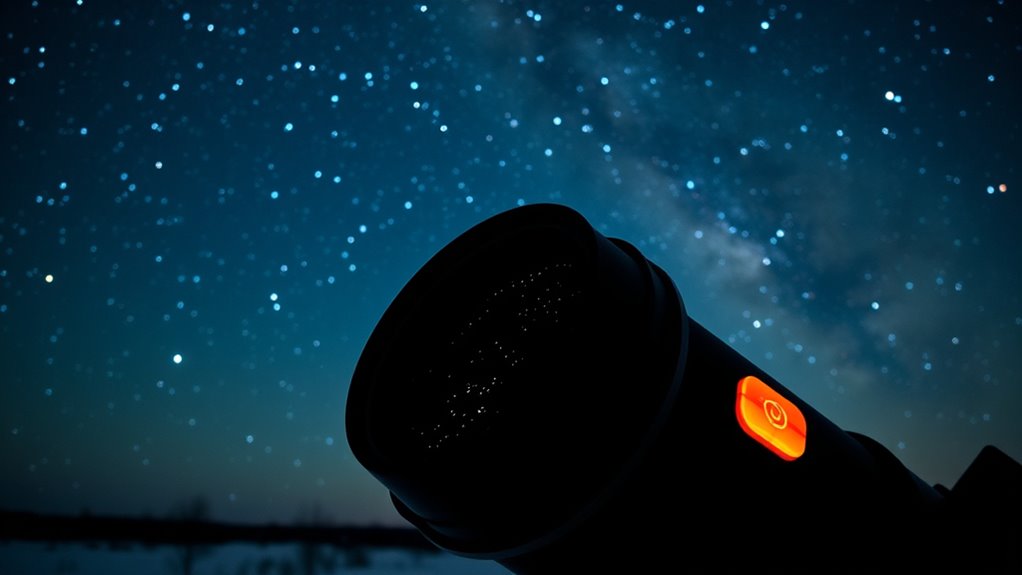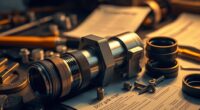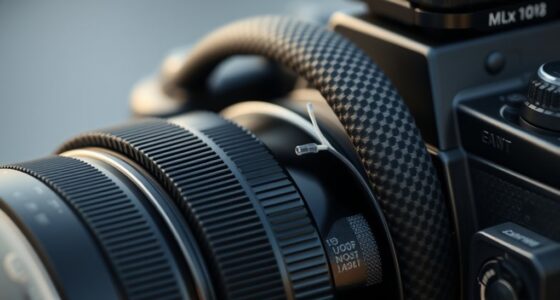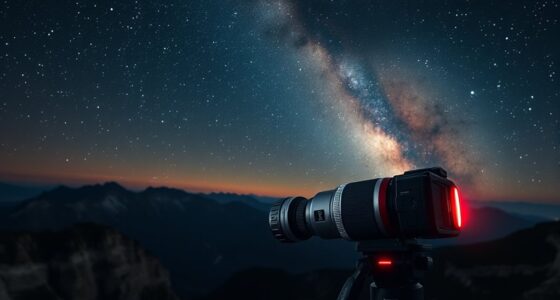If you want clear lenses and sharp nightscapes, I recommend checking out the top dew heaters like the JJC USB Lens Warmer for small lenses, SVBONY’s heater strips for telescopes and cameras, and larger options like the R-Sky strip for big telescopes. Each offers quick, reliable dew prevention, and easy setup for outdoor use. To find the best fit for your gear, consider compatibility and power options—stay with me to get all the details.
Key Takeaways
- Choose dew heaters compatible with your lens or telescope size, such as the JJC USB Lens Warmer or SVBONY models for optimal coverage.
- Prioritize units with adjustable temperature settings to prevent overheating and ensure effective fog prevention during long night sessions.
- Opt for portable, USB-powered or 12V models like the NEEWER or Extra Big Dew Heater for convenient outdoor use.
- Ensure secure attachment methods like velcro straps or flexible cords for quick setup and reliable operation in cold or humid conditions.
- Select high-performance dew heaters with even heat distribution, quick response, and durable construction to maintain clear optics for stunning nightscape captures.
JJC USB Lens Warmer for 80mm Lenses
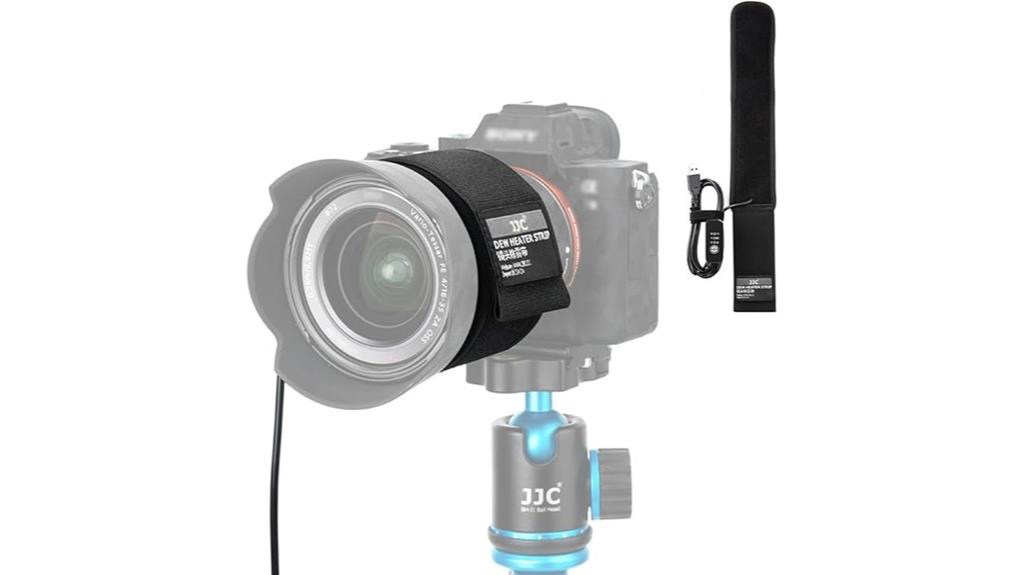
If you’re into widefield astronomy and need a reliable way to keep your lenses clear, the JJC USB Lens Warmer for 80mm lenses is an excellent choice. This dew heater strip is designed to prevent condensation on telescopes, astrophotography lenses, and viewfinder lenses up to 80mm in diameter. Made from high-quality materials, it heats quickly and insulates well, ensuring your lenses stay dry in cold conditions. With a 1.5-meter adjustable temperature regulator offering low, medium, and high settings, it’s versatile and easy to control. Powered via USB, you can connect it to power banks for long outdoor sessions, making it perfect for astrophotographers.
Best For: astrophotographers and outdoor telescope users seeking an effective solution to prevent lens condensation in cold environments.
Pros:
- Rapid heat transfer with high-quality insulation materials for effective condensation prevention.
- Adjustable temperature settings with a 1.5-meter regulator, including a low setting that works down to -40°C.
- USB-powered for convenient connection to power banks, ideal for long outdoor sessions.
Cons:
- Designed specifically for lenses up to 80mm in diameter, limiting use with larger equipment.
- May require additional accessories for optimal fit on certain lens shapes or sizes.
- Primarily suited for cold conditions; less effective in warm or humid environments.
SVBONY SV192 Dew Heater Strip for Telescope and Camera Lenses
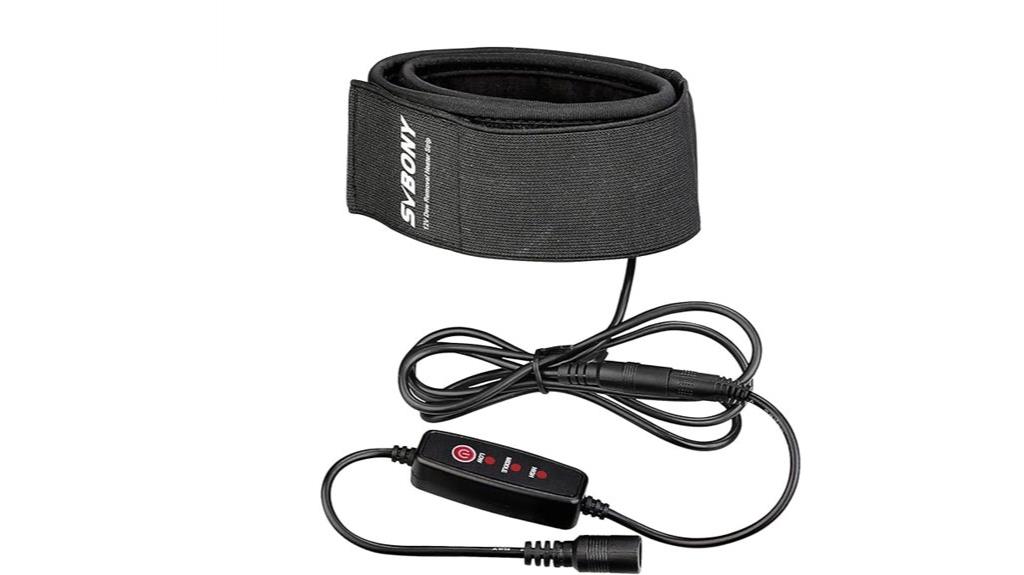
The SVBONY SV192 Dew Heater Strip is an excellent choice for astronomers who need reliable, even heating for large aperture camera lenses and telescopes. Its 560mm length is ideal for lenses with outer diameters below 178mm, ensuring all-encompassing coverage. Built with built-in aluminum for uniform heat distribution and alloy fiber wiring for rapid response, it maintains consistent temperatures efficiently. The three-layer insulation enhances safety and reduces heat loss. With a 120cm TPE power cord and adjustable temperature control featuring strong, medium, and weak modes, it offers customized performance. Its narrow 50mm width prevents interference with focusing and other accessories, making it a practical, effective dew prevention solution.
Best For: Amateur astronomers and astrophotographers seeking reliable, uniform dew prevention for large aperture camera lenses and telescopes with diameters below 178mm.
Pros:
- Provides fast, uniform heating to effectively prevent dew formation
- Adjustable temperature modes for customized performance
- Compact, narrow 50mm width minimizes interference with focusing and accessories
Cons:
- Designed specifically for lenses and telescopes with diameters below 178mm, limiting use with larger equipment
- Requires a 12V power source, which may necessitate additional power supplies in some setups
- May need careful installation to ensure optimal contact and performance
SVBONY SV172 Dew Heater Strip for Telescopes and Camera Lenses
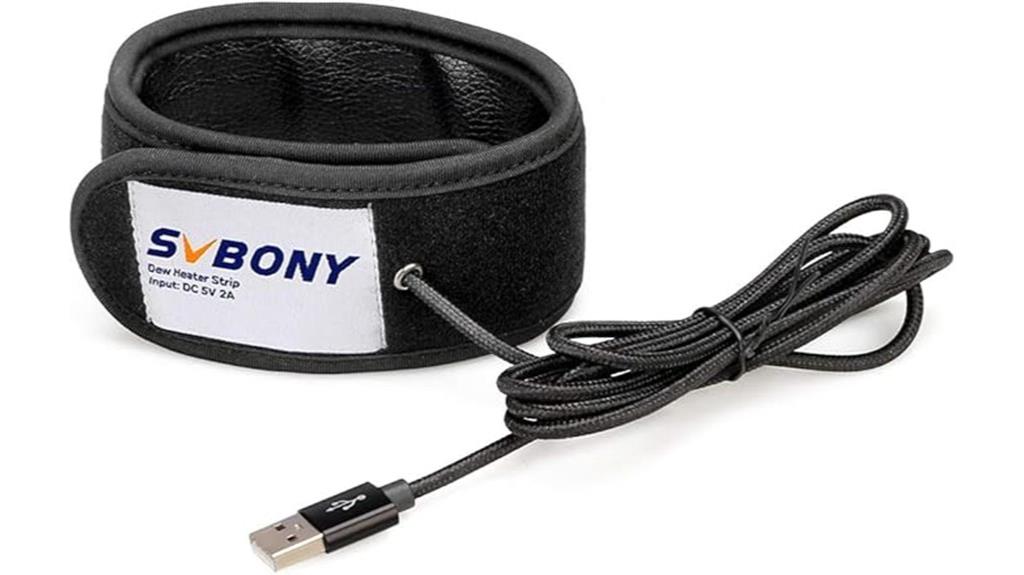
Designed for astronomers and astrophotographers who need reliable dew prevention, the SVBONY SV172 Dew Heater Strip offers even heating with its built-in aluminum film. Its 320 mm length effectively covers lenses and telescope components, preventing fogging and dew buildup. The three-speed adjustment lets me customize the heat intensity, ensuring ideal performance in various conditions. Quick startup means I can quickly warm my equipment without delay. Built with alloy fiber wiring and silicone insulation, it’s safe and durable. Powered via USB from power banks or laptops, its compact design minimizes interference, helping me maintain focus and capture clear, sharp images during my night sky sessions.
Best For: astronomers and astrophotographers seeking reliable dew prevention and consistent lens heating during night sky observation and photography.
Pros:
- Provides even heating with built-in aluminum film, preventing fogging and dew buildup.
- Three adjustable heat settings allow customization for various environmental conditions.
- Compact, USB-powered design minimizes interference with focusing and accessories.
Cons:
- Limited length (320 mm) may not cover larger or multiple lens surfaces simultaneously.
- Requires a compatible USB power source, which may not always be readily available in remote locations.
- The strip’s narrow width might restrict heat coverage on wider or multi-element lenses.
Extra Big Dew Heater for Telescopes

For astronomers with large 14–16” telescopes, the Extra Big Dew Heater offers essential dew protection by providing powerful, even heating for sizable optical tubes. Designed for 355–406 mm tubes, it’s compatible with SCT, Maksutov, and RASA models. Its high-power heating strip prevents dew buildup on large corrector plates, especially in humid conditions. The heater guarantees consistent warmth without hotspots, maintaining clear views. Powered by a 12V supply via RCA connector, it’s easy to integrate with standard dew controllers. Its durable, flexible cord and hand-assembled build make it dependable for outdoor use, ensuring your telescope stays dew-free during long observing sessions.
Best For: astronomers with large 14–16” telescopes seeking reliable dew protection and even heating in humid conditions.
Pros:
- Provides powerful, even heat to large optical tubes, preventing dew buildup effectively
- Compatible with SCT, Maksutov, and RASA telescopes, ensuring versatile use
- Durable, flexible cord and hand-assembled construction enhance reliability in outdoor environments
Cons:
- Requires a 12V power supply, which may necessitate additional adapters or batteries
- May be overpowered or unnecessary for smaller telescopes or less humid conditions
- Installation and setup might be more complex compared to smaller dew heaters
NEEWER USB Lens Heater for DSLR and Telescope
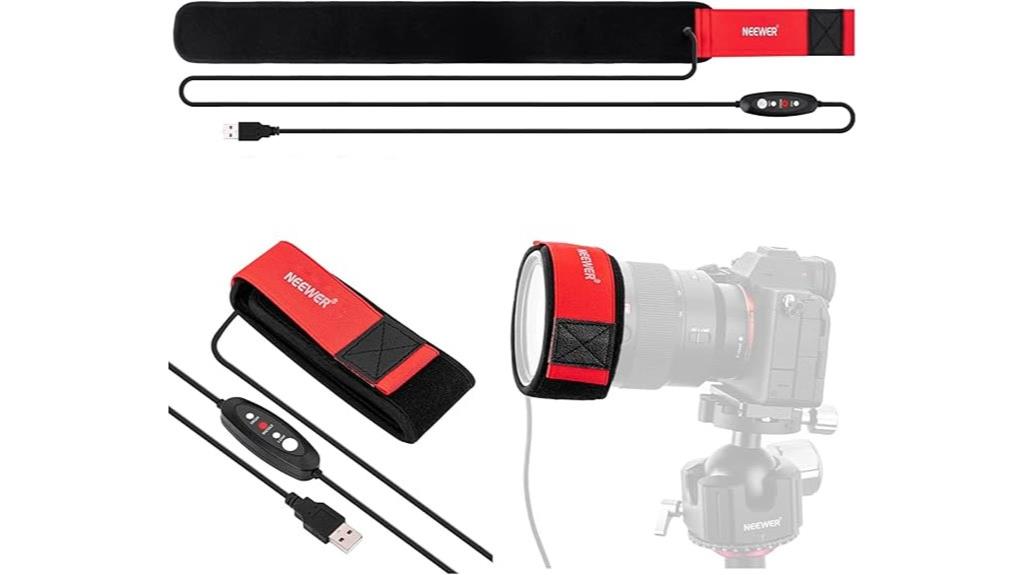
If you’re serious about astrophotography or cold-weather telescope observation, the NEEWER USB Lens Heater stands out as a reliable solution to prevent dew and condensation. It’s designed for lenses and telescopes up to 18.7 inches in circumference and 150mm in diameter, making it versatile for various equipment. The heater features three adjustable temperature settings, ensuring you can customize the warmth for different conditions. Powered via USB, it’s easy to use outdoors with portable power banks or indoors with USB adapters. Lightweight at just over 3.5 ounces, it wraps securely with velcro, providing quick, effective dew prevention during long nights under the stars.
Best For: astrophotographers, telescope users, and outdoor photographers seeking reliable dew prevention during cold weather conditions.
Pros:
- Effective at preventing dew, fog, and condensation on lenses and telescopes
- Adjustable temperature settings for customized warmth and comfort
- Lightweight, easy to secure with velcro, and compatible with portable USB power sources
Cons:
- Does not retain temperature settings after power is turned off, requiring reconfiguration
- Power cycle may cause the heater to turn on/off periodically, which could affect continuous operation
- Limited to equipment up to 18.7 inches in circumference and 150mm in diameter, not suitable for larger gear
Lens Warmer, LOSHARP Dew Heater for Telescope Lens Heating and Defogging
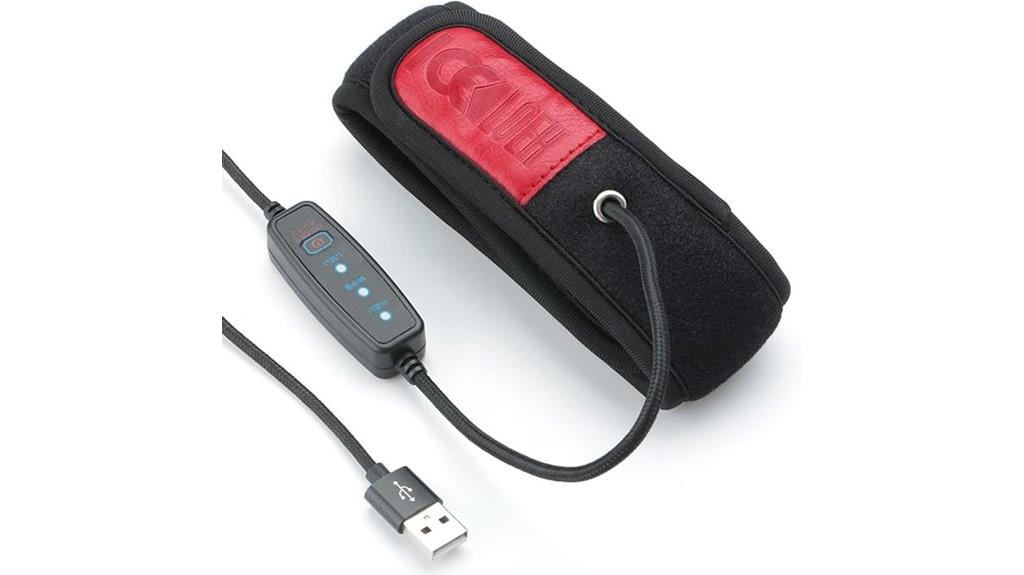
The LOSHARP Dew Heater stands out as an essential tool for astronomers who frequently observe in cold or humid conditions, as it quickly prevents lens fogging and dew buildup. Designed for telescope lenses, finderscopes, and digital cameras, it offers universal compatibility and easy installation. The USB-powered strip heats up rapidly within 5 seconds and features adjustable modes—strong, medium, and weak—to suit your needs. With intelligent temperature regulation up to 122°F, it maintains ideal clarity during your sessions. Its flexible design and quick disassembly make it simple to fit most lens sizes, ensuring your equipment stays clear and ready for stunning nightscape captures.
Best For: amateur and professional astronomers or photographers who need reliable lens defogging and dew prevention during cold or humid conditions.
Pros:
- Quick start-up within 5 seconds for immediate use.
- Adjustable temperature modes (strong, medium, weak) for customized heating.
- Universal compatibility and flexible design fit most lenses and scopes easily.
Cons:
- Limited to USB power sources, which may require additional accessories for some setups.
- Slightly higher price point compared to basic dew heaters.
- Requires monitoring to prevent overheating, especially in prolonged use.
250mm DC Lens Heater for Telescopes and Cameras
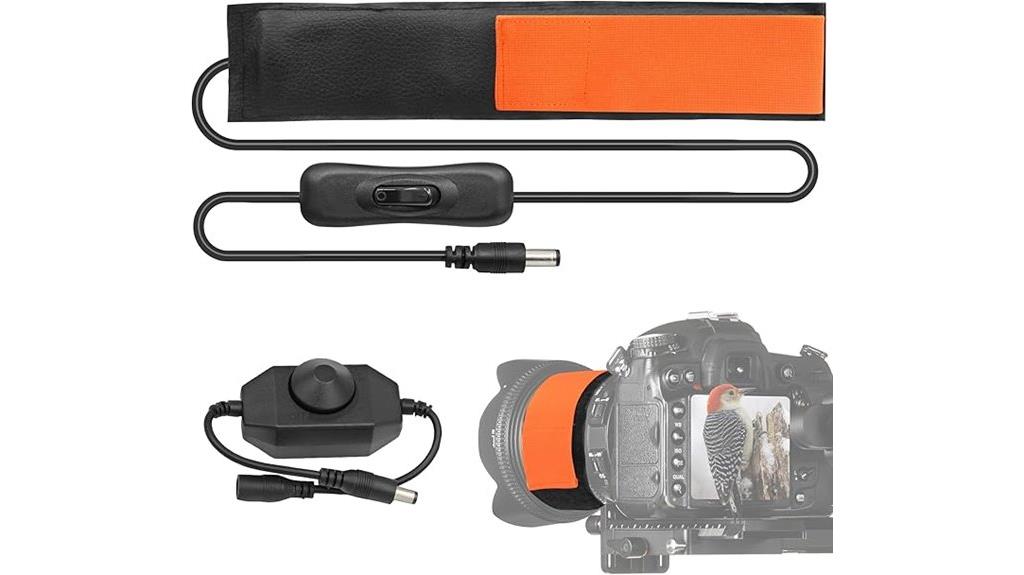
The 250mm DC Lens Heater is a smart choice for amateur astronomers and photographers who need an affordable, reliable solution to prevent dew on their lenses and finderscopes. Designed for lenses under 80mm in diameter, it’s compatible with most telescopes, cameras, and accessories. It features a stepless temperature regulator and an LED dimmer for precise heat control, ensuring your equipment stays clear in cold or humid conditions. Powered via a DC port, it connects easily to power banks or other sources. Despite being budget-friendly, it offers effective dew prevention, making it a practical tool for anyone wanting to protect their gear during night sky observations.
Best For: amateur astronomers and photographers seeking an affordable, effective dew prevention solution for lenses and finderscopes under 80mm in diameter.
Pros:
- Easy to connect with a DC power source like a power bank for portable use
- Precise temperature control with stepless regulator and LED dimmer
- Compatible with most telescopes, cameras, and accessories
Cons:
- Slightly over 2 amps draw may require a higher capacity power source
- Limited to lenses with outer diameter less than 80mm, not suitable for larger equipment
- Some users recommend using the switch rather than the dimmer knob to turn off the heater
Dew Heater Strip – 6.5 Length # DN02
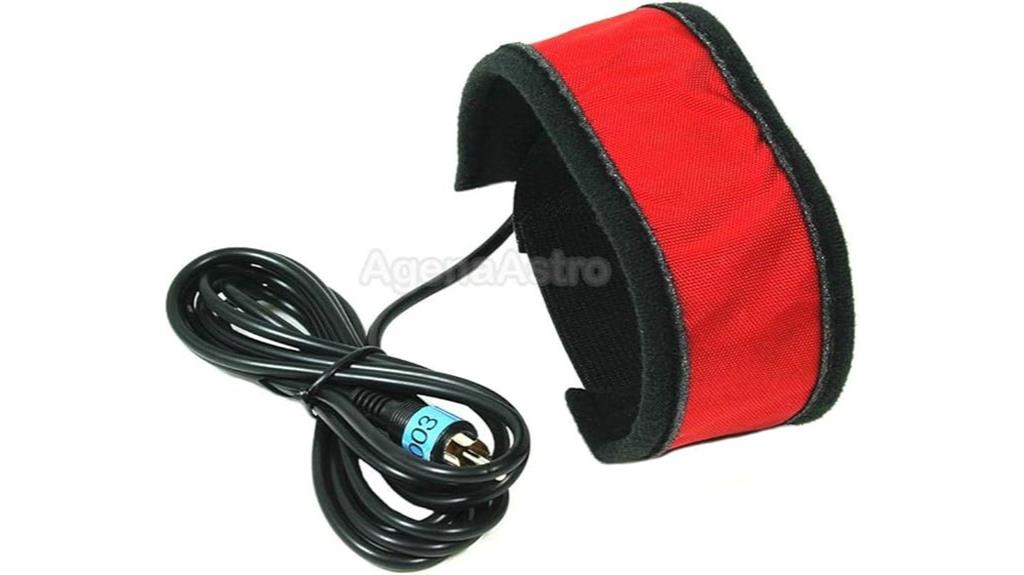
Designed for precise dew prevention on smaller optical devices, the Dew Heater Strip – 6.5 Length # DN02 is an ideal choice for astronomers with eyepieces, finderscopes, or telescopes up to 16 inches. Made in the USA by AFAB, it operates at 12 volts, delivering even heat distribution without hot spots or burnouts. Its innovative, durable design guarantees reliable dew prevention, while feeling barely warm during use. Measuring 6.5 inches, this strip is perfect for smaller accessories. Easy to connect with a compatible 12V power supply, it offers a cost-effective, efficient solution to keep your optics clear during those chilly nights.
Best For: amateur astronomers and astrophotographers seeking an efficient, reliable dew prevention solution for small optical accessories up to 16 inches in size.
Pros:
- Provides even heat distribution without hot spots or burnouts
- Easy to connect with standard 12V power supplies and compatible controllers
- Durable, innovative design backed by over 30 patents and decades of improvements
Cons:
- Requires a separate 12V power source with an RCA/phono connector (not included)
- Length limited to 6.5 inches, suitable mainly for smaller accessories
- Not designed for direct connection to AC mains or USB power sources
JJC USB Lens Warmer for Telescopes and Camera Lenses
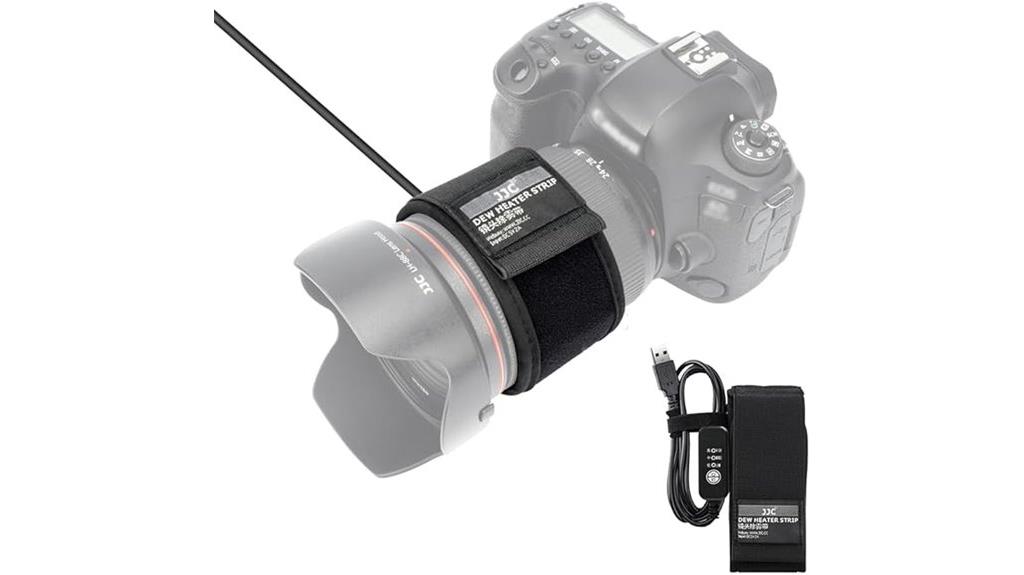
If you’re serious about preventing dew from fogging up your lenses during outdoor astronomy sessions, the JJC USB Lens Warmer offers an excellent solution. It fits lenses with diameters from 80mm to 110mm and works on telescopes, astrophotography lenses, viewfinder lenses, and digital camera lenses. Made from high-quality materials, it heats quickly and insulates well, keeping your equipment clear. The USB-powered warmer features three adjustable temperature levels, ideal for cold environments down to -40°C. Plus, it’s versatile—great for insulating drinks or bottles too. Its quick installation and compatibility with power banks make it perfect for extended outdoor sessions.
Best For: Amateur and professional astronomers, photographers, and outdoor enthusiasts seeking to prevent lens fogging and maintain equipment performance in cold environments.
Pros:
- Effectively prevents condensation on telescopes and camera lenses, ensuring clear images.
- USB-powered with adjustable temperature settings for versatile use in extreme cold conditions.
- Easy to install and compatible with power banks, making it ideal for extended outdoor sessions.
Cons:
- Limited to lenses with diameters between 80mm and 110mm, may not fit all equipment.
- Requires a power source such as a USB power bank, which may add bulk to outdoor gear.
- May not provide uniform heating for very large or irregularly shaped lenses.
Dew Heater Strip for 11” Telescopes
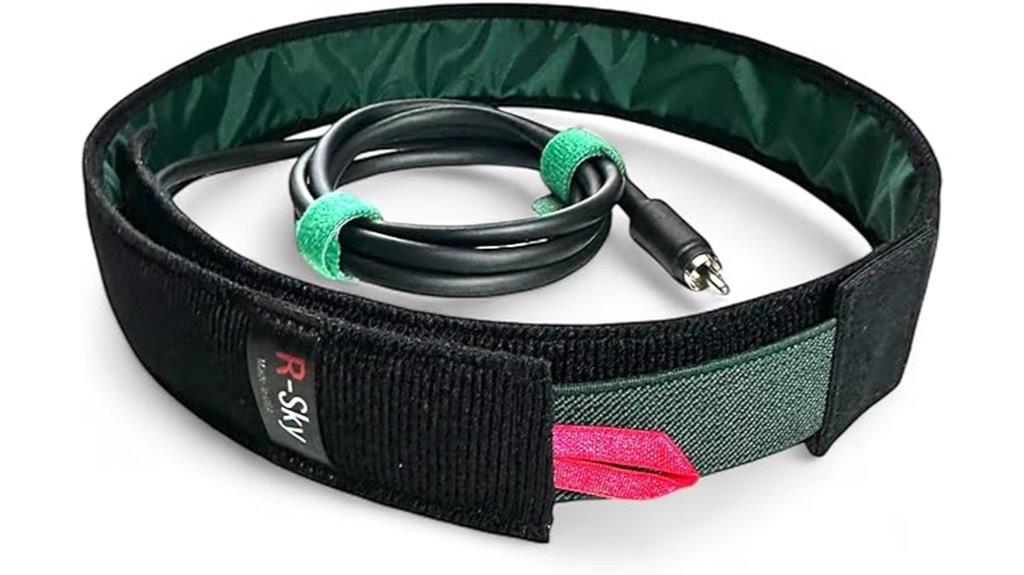
For astronomers with 11-inch telescopes, the Dew Heater Strip offers an effective solution to prevent dew buildup on critical optical components. Designed specifically for 11” systems, it maintains a consistent surface temperature and guarantees even heat distribution, preventing hot spots. The soft, durable 47-inch power cord remains flexible even in freezing temperatures, making setup easy and tangle-free. Hand-assembled by R-Sky Astro Instruments, it’s tested for durability and reliable operation. Compatible with standard 12V power sources via RCA plug, this heater strip provides a simple, efficient way to keep your corrector plates and lenses clear, ensuring ideal viewing during your night sky adventures.
Best For: amateur and professional astronomers using 11-inch telescopes seeking effective dew prevention on their optical components.
Pros:
- Ensures even heat distribution to prevent hot spots and dew formation.
- Flexible, tangle-free 47-inch cord maintains performance in cold temperatures.
- Hand-assembled and tested for durability, reliability, and high performance.
Cons:
- Designed specifically for 11-inch telescopes; may not fit other sizes.
- Requires a standard 12V power source with RCA connection, limiting compatibility with some setups.
- Installation may require some setup time and familiarity with dew control systems.
Astromania USB Lens Warmer Heater for Telescope and Camera
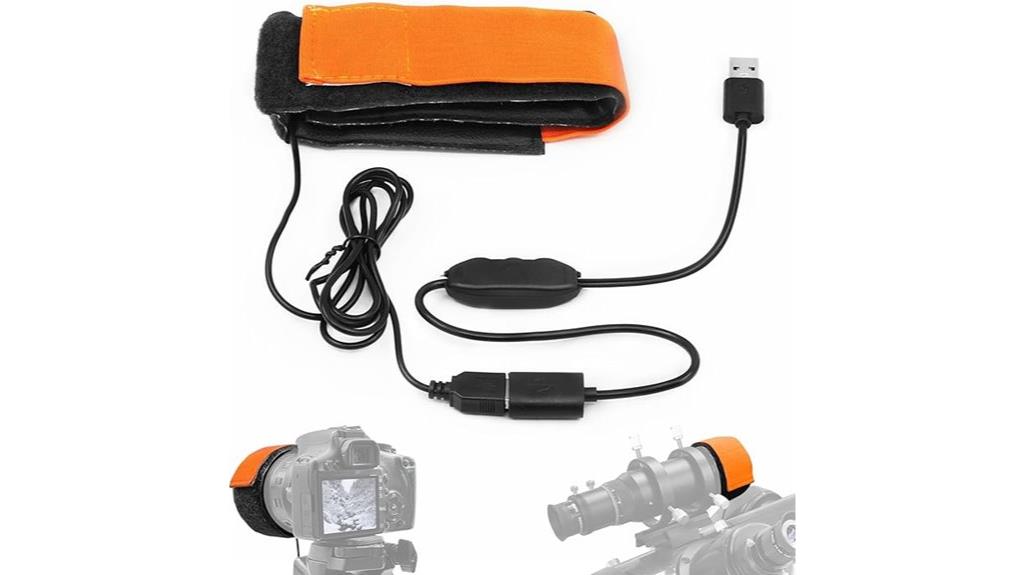
The Astromania USB Lens Warmer Heater stands out as an affordable and versatile solution for amateur astronomers and astrophotographers who need to prevent dew on their lenses and telescopes. Designed for lenses up to 80mm in diameter, it’s adjustable and compatible with most cameras and telescopes within that size range. The flexible heating strip attaches securely with Velcro, and the stepless temperature regulator allows precise control. Powered via USB, it’s portable and easy to use in the field. While its heating capacity is moderate—raising temperatures by about 20-25°F—it effectively prevents fogging in humid conditions, making it a practical and budget-friendly dew prevention option.
Best For: amateur astronomers and astrophotographers seeking an affordable, portable solution to prevent dew on lenses and telescopes up to 80mm in diameter.
Pros:
- Adjustable stepless temperature control for precise heating.
- Easy to attach with strong Velcro, suitable for various lens sizes.
- USB-powered, making it portable and compatible with power banks and USB sources.
Cons:
- Heating capacity is moderate, raising temperature only 20-25°F above ambient.
- May require trial and error to find optimal temperature settings.
- Stiff heating strip may limit conformability around some lens shapes.
Dew Heater for Camera Lenses
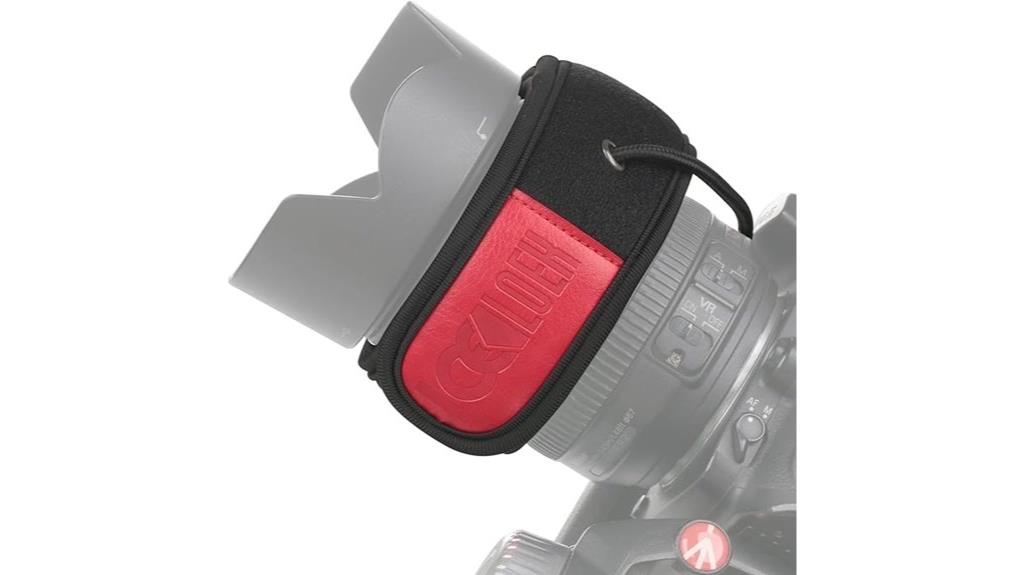
Dew heaters for camera lenses are essential tools for astrophotographers and outdoor enthusiasts who need reliable fog prevention in cold or humid conditions. The LOSHARP Lens Heater is a compact, USB-powered device that quickly heats lenses to prevent dew and condensation, ensuring clear images during night shoots or outdoor observations. It fits most telescope finders, digital cameras, and Canon lenses, thanks to adjustable velcro. The heater reaches around 86°F (30°C) in seconds and maintains warmth without excessive heat. Its lightweight design makes it easy to install and remove, making it a practical, cost-effective solution for keeping lenses fog-free in challenging environments.
Best For: outdoor photographers, astronomers, and videographers who need reliable lens protection in cold or humid conditions.
Pros:
- Quickly heats lenses to prevent dew and condensation, ensuring clear images.
- Compatible with most telescope finders, camera lenses, and eyepieces with adjustable velcro for easy installation.
- USB-powered, lightweight, and portable, suitable for outdoor use with power banks or USB adapters.
Cons:
- No built-in on/off switch or temperature controls, relying solely on plugging/unplugging.
- Limited wire length may restrict positioning flexibility during use.
- Some users report switch durability issues over extended outdoor exposure or multiple uses.
Dew Heater Strip for 9–10” Telescopes
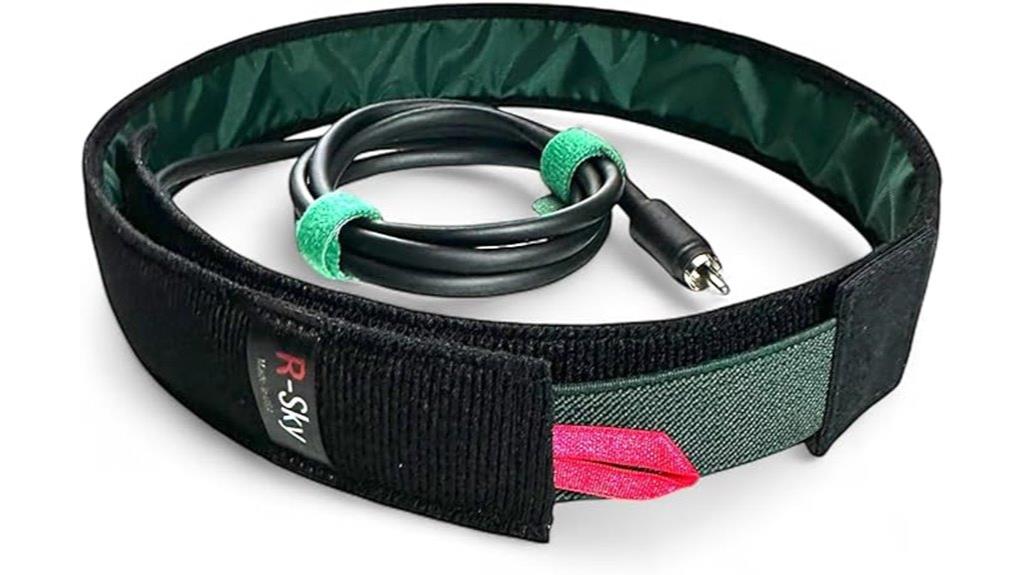
If you’re using a 9–10” telescope in humid conditions, a Dew Heater Strip offers a reliable solution to prevent dew buildup during your observing sessions. Designed specifically for these-sized telescopes, it features a high-power anti-dew heater that provides even warmth without hot spots, ensuring clear views. The flexible, durable cord (47” / 120 cm) remains soft in cold weather and is easy to handle. Its standard RCA plug makes it compatible with most dew controllers and power supplies, while the tangle-free design simplifies setup. Hand-assembled by R-Sky, this strip guarantees quality, performance, and long-term reliability for your astronomical pursuits.
Best For: astronomers using 9–10” telescopes in humid conditions seeking an effective dew prevention solution.
Pros:
- High-power anti-dew heating ensures consistent, even warmth without hot spots.
- Flexible, durable cord remains soft in cold weather for easy handling.
- Tangle-free wire layout simplifies setup and reduces knots during nighttime use.
Cons:
- Compatibility limited to 9–10” telescopes; may not fit other sizes.
- Requires a compatible dew controller or power supply with RCA plug.
- Hand-assembled by R-Sky, which may lead to limited availability or higher cost compared to mass-produced options.
Extra Big Dew Heater Strip for Large Telescopes by R-Sky
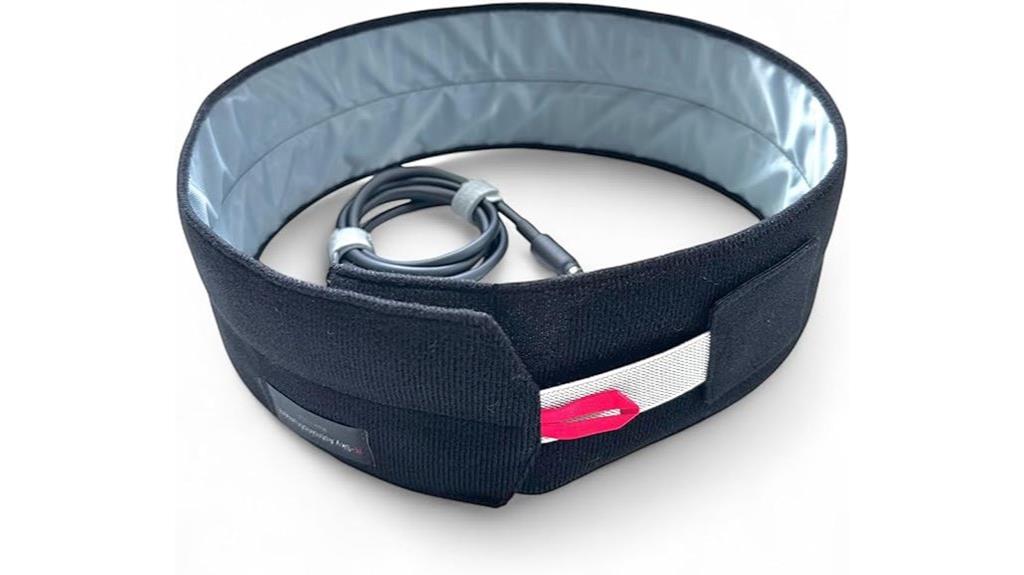
For astronomers using large telescopes between 7 and 16 inches, the Extra Big Dew Heater Strip by R-Sky offers powerful, consistent heat to prevent dew and condensation. Designed specifically for larger optics, it provides even heat distribution without overheating, ensuring clear views during long sessions. The 12V RCA connection makes it compatible with standard dew controllers and power supplies, while the flexible, tangle-free 47-inch cable remains manageable in cold weather. Hand-assembled with high-quality materials, this dew heater strip is built for durability and reliable performance in challenging conditions, helping you keep your optics dry, sharp, and ready for stunning astrophotography or visual observing.
Best For: astronomers and astrophotographers using large 7-16 inch telescopes who need reliable dew prevention during extended observation or imaging sessions.
Pros:
- Provides powerful, consistent heat to prevent dew and condensation even in extreme humidity and cold conditions.
- Features even heat distribution to avoid overheating and fogging of optical surfaces.
- Flexible, tangle-free 47-inch cable remains manageable in cold weather, ensuring easy setup and use.
Cons:
- Requires a compatible dew controller or power supply with a 12V RCA connection for optimal operation.
- Hand-assembled construction may result in slight variability between units.
- Dimensions (5 x 5 x 5 inches) may limit flexibility for very large or uniquely shaped telescope setups.
Astromania 25cm DC Lens Heater Warmer Dew Heater Strip
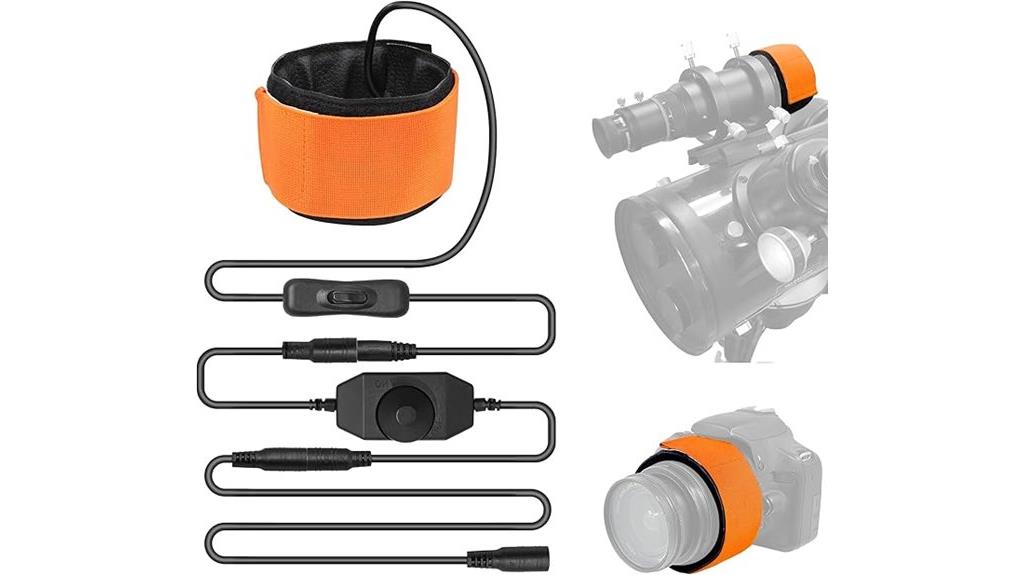
The Astromania 25cm DC Lens Heater Warmer Dew Heater Strip is an excellent choice for amateur astronomers seeking an affordable and portable solution to prevent dew buildup on their telescopes and lenses. Designed for devices with an outer diameter less than 80mm, it’s versatile and easy to install on most scopes and cameras. The stepless temperature regulation allows precise adjustments, and it connects easily to power banks or DC outlets. While effective at preventing dew in humid conditions, some users report overheating issues and inconsistent control, and the rubber base may leave residues. Overall, it’s a budget-friendly option that works well with some caution.
Best For: amateur astronomers and photography enthusiasts seeking an affordable, portable dew prevention solution for telescopes and lenses under 80mm in diameter.
Pros:
- Easy to install and remove with adjustable length for various lenses and scopes
- Stepless temperature regulation for precise control
- Compatible with portable power sources like power banks for on-the-go use
Cons:
- Reports of overheating and inconsistent control, leading to potential damage
- Rubber base may leave residues and emit odors after removal
- Build quality and regulation stability are variable, with some units malfunctioning
Factors to Consider When Choosing Dew Heater for Widefield
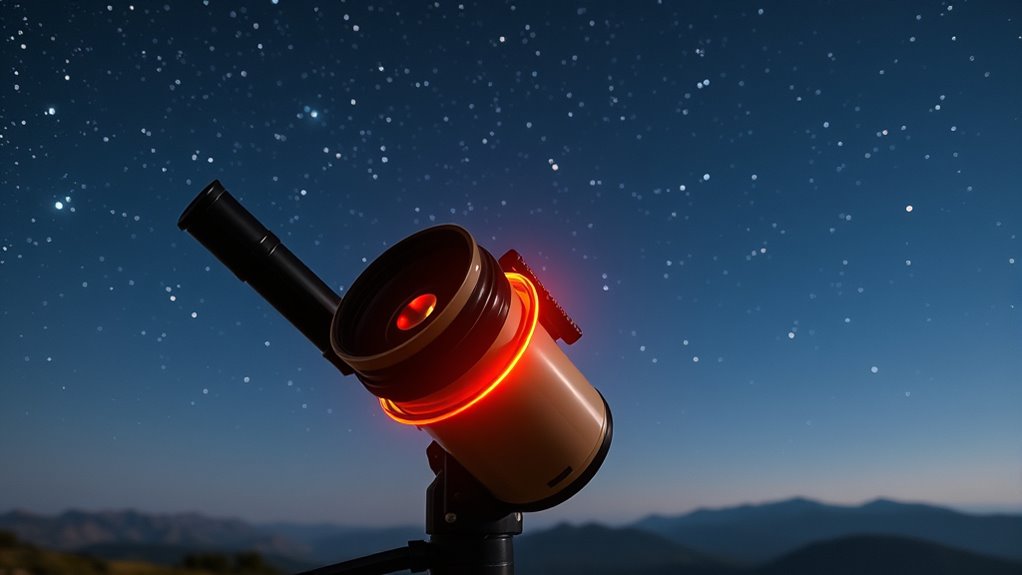
When selecting a dew heater, I focus on compatibility with my lens size and how effectively it heats without wasting energy. I also consider how precise the temperature control is, as well as the power options that suit my setup. Finally, I look for durability in cold weather to ensure reliable performance during long observing sessions.
Compatibility With Lens Size
Choosing a dew heater that fits your lens size is essential to guarantee effective coverage and secure attachment. First, measure your lens’s outer diameter to ensure the heater’s maximum compatible size surpasses it, avoiding tight fits or gaps. Check if the heater’s width or adjustable features can accommodate your specific lens circumference for even heating. Also, consider the length or design to ensure it doesn’t interfere with focusing or other accessories. Confirm the attachment method, whether velcro, clips, or other, to keep the heater firmly in place during observations. Carefully review product specifications to verify size limits and compatibility with your equipment. Proper sizing ensures the heater stays securely attached and provides uniform heat, preventing dew formation effectively.
Heating Power and Efficiency
Selecting a dew heater with appropriate heating power directly impacts its ability to keep your widefield equipment free of dew. Higher wattage heaters provide faster, more effective heating, which is vital during damp or humid nights. However, efficiency isn’t just about power; it’s also about even heat distribution to avoid cold spots that can cause condensation. Adjustable power levels allow you to optimize energy use and adapt to changing conditions, preventing overheating and conserving power. Good insulation and thermal materials reduce heat loss, ensuring the heater responds quickly to temperature changes. Additionally, a high duty cycle enables continuous operation without performance issues. Overall, balancing sufficient wattage with efficiency features ensures your equipment stays dew-free without wasting energy.
Temperature Control Options
Temperature control options are essential in ensuring your dew heater maintains the right surface temperature to prevent dew buildup effectively. Adjustable settings allow me to fine-tune the heat output, matching environmental conditions and avoiding overheating. Some models feature digital or analog controllers with multiple levels—low, medium, or high—making it easy to optimize performance. I prefer dew heaters with automated temperature regulation, which use sensors or thermostats to keep a consistent surface temperature. Advanced options with feedback loops and thermistors monitor temperature and adjust heat dynamically, boosting efficiency and safety. The right control system helps prevent dew without risking damage to sensitive optics, conserving energy, and ensuring reliable operation during long night sessions. Choosing the right control options is key for effective dew prevention.
Power Supply Flexibility
A flexible power supply is essential for dew heaters, especially when I need to adapt to different environments or setups. Using options like USB or DC power allows me to connect easily to various sources such as power banks, car chargers, or portable batteries. This guarantees I can operate continuously in remote locations without standard electrical outlets. Compatibility with common power sources like 12V DC or 5V USB broadens the dew heater’s usability across different models and setups. Flexibility in power options also lets me extend observation or imaging sessions by using high-capacity batteries or multiple sources simultaneously. Choosing a dew heater that supports adjustable voltage or multiple input types helps optimize performance based on environmental conditions and available resources, making it a practical choice for fieldwork.
Durability in Cold Weather
Have you ever experienced a dew heater failing just when cold weather hits? It’s frustrating, and it highlights the importance of durability. When choosing a dew heater for cold conditions, I look for models with durable, flexible cords made from high-quality materials—these resist cracking and breaking in freezing temperatures. Insulation layers and heat-resistant components are essential, preventing internal damage during prolonged cold exposure and keeping performance steady. Robust connectors and secure attachment methods help avoid disconnection from ice, snow, or frost buildup. Proper wattage and even heat distribution ensure the heater won’t overheat or fail prematurely in low temperatures. Regular maintenance, along with careful handling of wiring and components, further extends the lifespan of the device in harsh, cold environments.
Ease of Installation
When selecting a dew heater for widefield astronomy, ease of installation is crucial to guarantee quick setup and reliable performance in the field. A flexible, adjustable strap or adhesive surface helps secure the heater around different lens sizes without hassle. Look for a model with a simple power connection, such as USB or low-voltage DC, to avoid complex wiring and save time. A straightforward temperature control or regulator makes it easy to adjust settings on the fly, even without technical expertise. Additionally, a lightweight, slim design minimizes bulk, making installation faster and less cumbersome. Clear, user-friendly instructions or labels are essential to simplify the process during outdoor use, ensuring you can set up quickly and focus on capturing stunning nightscapes.
Versatility for Different Equipment
Choosing a dew heater that adapts to various equipment sizes and types makes outdoor astrophotography much more convenient. I look for heaters with adjustable straps or flexible materials that fit lenses from 80mm to over 110mm, ensuring compatibility with different gear. Multiple heat settings or an adjustable regulator are essential to fine-tune warmth based on humidity and temperature changes. Compatibility with diverse power sources, like USB, 12V DC, or built-in controllers, adds to its versatility across setups. Quick installation and removal are vital, so I prefer models with easy-to-use straps or clips. Multi-functionality also matters—being able to insulate thermoses or temperature-sensitive items makes the heater useful for various outdoor activities. Overall, a versatile dew heater simplifies my setup and enhances my astrophotography experience.
Frequently Asked Questions
How Do Dew Heaters Affect Overall Camera Image Quality?
Dew heaters help improve my camera image quality by preventing moisture buildup on the lens, which can cause blurred or foggy images. When I use a dew heater, I notice sharper, clearer photos with better contrast and detail. It also reduces the need for post-processing corrections. Overall, dew heaters guarantee my equipment stays dry and my images stay crisp, especially during long night sessions in humid or cold conditions.
Are Dew Heaters Energy-Efficient for Long Outdoor Sessions?
Yes, dew heaters can be quite energy-efficient for long outdoor sessions if you choose the right one. I find that low-power, adjustable heaters use minimal energy while preventing dew buildup effectively. By carefully balancing power settings, I conserve battery life and reduce unnecessary power drain. This way, I keep my gear clear and my session longer without wasting energy, making dew heaters both practical and economical for extended astronomy outings.
Can Dew Heaters Be Used Simultaneously With Other Telescope Accessories?
Yes, dew heaters can be used simultaneously with other telescope accessories. I always make sure to use a power supply that can handle multiple devices, so I connect my dew heater alongside my camera, mount, and focusers without issue. Just be mindful of power draw to avoid overloads. With proper setup, you’ll keep your lens clear and your entire system running smoothly during those long night sessions.
What Safety Precautions Should Be Followed When Installing Dew Heaters?
Think of installing dew heaters like wiring a delicate circuit—precision and care matter. I always double-check the power source and guarantee proper insulation to prevent shorts or shocks. Avoid overloading circuits, and use a voltage regulator to maintain stability. Wearing gloves and working in a dry environment also minimizes risk. Following these safety steps keeps my gear and I protected, so I can focus on capturing those breathtaking nightscapes.
How Do Ambient Temperature and Humidity Impact Dew Heater Performance?
Ambient temperature and humidity greatly affect dew heater performance. When it’s colder, dew forms more quickly, so I need a stronger or more active heater. High humidity also increases the risk of dew buildup, requiring continuous or higher settings. I always monitor these conditions closely, adjusting my heater’s power accordingly to keep my lens clear without wasting energy or damaging equipment. Proper adjustment ensures ideal performance in changing weather.
Conclusion
So, after all this, you’d think choosing the perfect dew heater is a breeze, right? Turns out, even in astronomy, the simplest solution—keeping your gear dry—can be surprisingly tricky. But don’t worry, with the right dew heater, you’ll keep your lenses clear and your nightscapes stunning. Ironically, the hardest part might just be resisting the urge to buy one of everything on this list—because who doesn’t love a well-heated lens?
